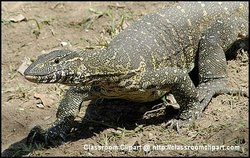Monitor lizard
|
|
| Monitor lizards | ||||||||||||||
|---|---|---|---|---|---|---|---|---|---|---|---|---|---|---|
 Monitor Lizard, Masai National Reserve, Kenya Africa]] | ||||||||||||||
| Scientific classification | ||||||||||||||
| ||||||||||||||
| Species | ||||||||||||||
|
Many, see text. |
Monitor lizards are the family Varanidae, a group of lizards which includes the largest living lizard, the Komodo Dragon. Varanidae contains only a single genus: Varanus.
In Australia monitor lizards are known as goannas (See main article).
Evolutionary Overview
Monitor lizards are considered to be the most highly developed lizards, possessing a rapid metabolism (for reptiles), several sensory adaptations that benefit the hunting of live prey, and a lower jaw that may be unhinged to facilitate eating large prey animals. The latter adaptation reveals the other relatives of the monitor lizards: snakes (Serpentes) are believed to have evolved from a sister group to the Varanidae.
Origin of Name

Monitor Lizard. Masai National Reserve, Kenya Africa. Image provided by Classroom Clipart (http://classroomclipart.com)
